Rolling Stock
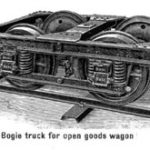

Status: Operational, under restoration
The first steel-framed bogies used on the Rubicon to Alexandra tramway were purchased in 1911 by the Rubicon Lumber & Tramway Company. These trucks were a product of “Bochumer Verein für Bergbau und Gusstahlfabrikation” [Bochum Union for Mining and Steel Casting Manufacture]. The Company’s works were established in the Ruhr industrial district at Bochum, Germany, in 1842, and its products won two first prizes at the Centennial Exhibition in Melbourne in 1888. It employed between about 9,000 men, and had its own collieries and iron ore mines producing 650,000 tons of coal and 40,000 to 60,000 tons of iron ore per year. Bochum Union had its own works railway with forty kilometres of track, twelve locomotives and 350 wagons. Its catalogues offered everything from a single truck to a complete light railway, including locomotives. The Company is still in the railway business today.
When the Lumber Company lost control of the Rubicon tramway in 1935, the Bochum Union trucks were set aside until purchased with the rest of the Company’s assets by Ruoak Timbers in 1938. Seventeen Bochum Union trucks survive today at the ATT.


Status: Static Display
The ATT has two types of 18½-inch (460mm) gauge wagons on display. Both wagons came from the Commonwealth Explosives factory at Maribyrnong in Melbourne’s western suburbs. Both have gun-metal wheels, as avoiding sparks was understandably a priority in an explosives factory. Both wagons also have water tanks to drip water on the wheels as an added precaution.
The first type is a yellow box cordite wagon. Cordite, an explosive used in artillery, was manufactured and pressed into thin sheets, which still contained a quantity of acetone solvent from the manufacturing process. The sheets of cordite were laid in racks of perforated trays in the cordite wagons, which were hand-pushed to the cordite drying-house where the trucks were coupled together in rakes and warm air was blown through them. The acetone, being very volatile, was evaporated out of the cordite and recovered to be re-used in the manufacturing process.
The second type of wagon is a general transport wagon used in the Propellant Section of the factory.


Status: Operational
The Alexandra Timber Tramway has a number of hopper wagons, sometimes known as “side-tipping skips” or “tumbling tommies”. These were widely used whenever a bulk commodity or waste product had to be transported and then easily tipped by one man. A large number were used in the construction of the Sugarloaf Dam (first Eildon Weir) between 1914 and 1927. They were also used on the construction of the Rubicon hydro-electric scheme, in road-metal quarries and, sometimes, as transport for sawdust from a sawmill to the sawdust heap. Most of the examples seen at the ATT were obtained with Malcolm Moore 1049 of 1943 and were used on the ash disposal line at the State Electricity Commission generating station at Yallourn.
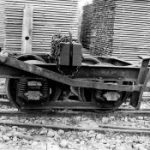
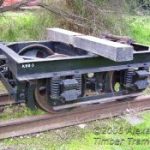
Status: Operational, under restoration
The Kelly & Lewis bogie pictured is one of those built in 1935 and 1936 for Rubicon sawmillers Clark & Pearce (later Ruoak Timbers Pty Ltd) for use on the Rubicon to Alexandra Tramway. A delivery of twenty trucks accompanied the first Kelly & Lewis diesel locomotive in December 1935 and cost 33 pounds for each truck. A further delivery of twenty trucks arrived with the second diesel locomotive in 1936. Every second truck was fitted with brakes. The trucks are clearly a copy of the Bochum Union trucks owned by Ruoak’s predecessor, the Rubicon Lumber & Tramway Company, but the frames are welded rather than riveted. The axles run in plain white-metal bearings and are lubricated with an oil reservoir above the axlebox feeding via a worsted-wick into a second reservoir and wiper pad underneath the axle.
When the tramway closed in 1947, all of the bogies owned by Ruoak were pressed into service around the mill. Sixteen Kelly & Lewis bogies survive today at the Alexandra Timber Tramway. All but one have had the brake handle cut off when they were used to move timber around the mill, but are otherwise substantially complete.
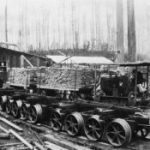
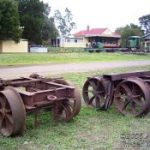
Status: Operational, under restoration
The ATT has on display a large number of wheel sets for log bogies designed to work over wooden-railed tramways. These wheel sets are characterised by wide treads and deep flanges, an absence of springing, and a very simple lubrication system consisting of a dab of grease applied to the axle with a stick in the vicinity of each axlebox. Such vehicles were robust, and all the sawmiller had to buy from the ironmonger were the wheel sets and axle boxes, the remainder of the metal parts being easily made by the mill blacksmith and all of the timber for the frame obtainable locally at the sawmill.
In the late 1930s, some sawmillers started constructing log bogies with steel frames. These were even more robust and tended to last much longer. The ATT has on display three bogies of this type on 3-ft (914mm) gauge.
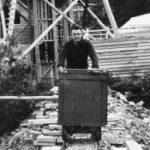

Status: Static Display
The standard Victorian mining truck was box-shaped and tipped through an end door. They were made in a variety of gauges of which 15-inch, 18-inch and 24-inch gauge were the most common. Each could carry about half-a ton of stone, and were generally pushed by hand, with the gradient so arranged as to be both gentle and in favour of the load. The examples illustrated are 2-ft gauge and were purchased by an ATT member from a second-hand machinery dealer. They are reputed to have been originally used in a mine in Gippsland.
Alexandra started life as a gold-rush town but, unfortunately, only one original mining truck used on the Alexandra goldfield appears to have survived. This too is on display at the ATT.
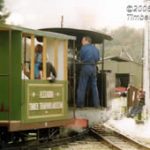
Status: Operational
The ATT currently has two passenger cars, both built by Denys Steinhauser at his Kiewa Works in north-eastern Victoria.
The larger of the two cars was built specifically for the ATT and was funded by the former Apex Club of Alexandra. The doors in this car are from the toilets on a NSWGR “Ashworth” car. The smaller of the two cars was built for the now-defunct Yangardook Tramway at Toolern Vale, where it was painted red and named “The Dustlander”. It was purchased by the ATT in the late 1980s and repainted green for use at Alexandra. This car is fitted with seats from a former Melbourne cable-tram trailer.
Both cars ride on 4-wheel bogies formerly used on the Rubicon to Alexandra Tramway. There are two types of bogies in use, the Bochum Union bogie and the Kelly & Lewis bogie.

